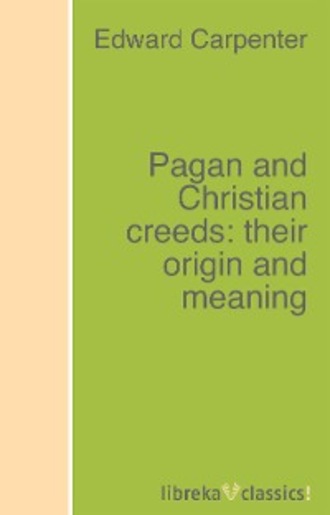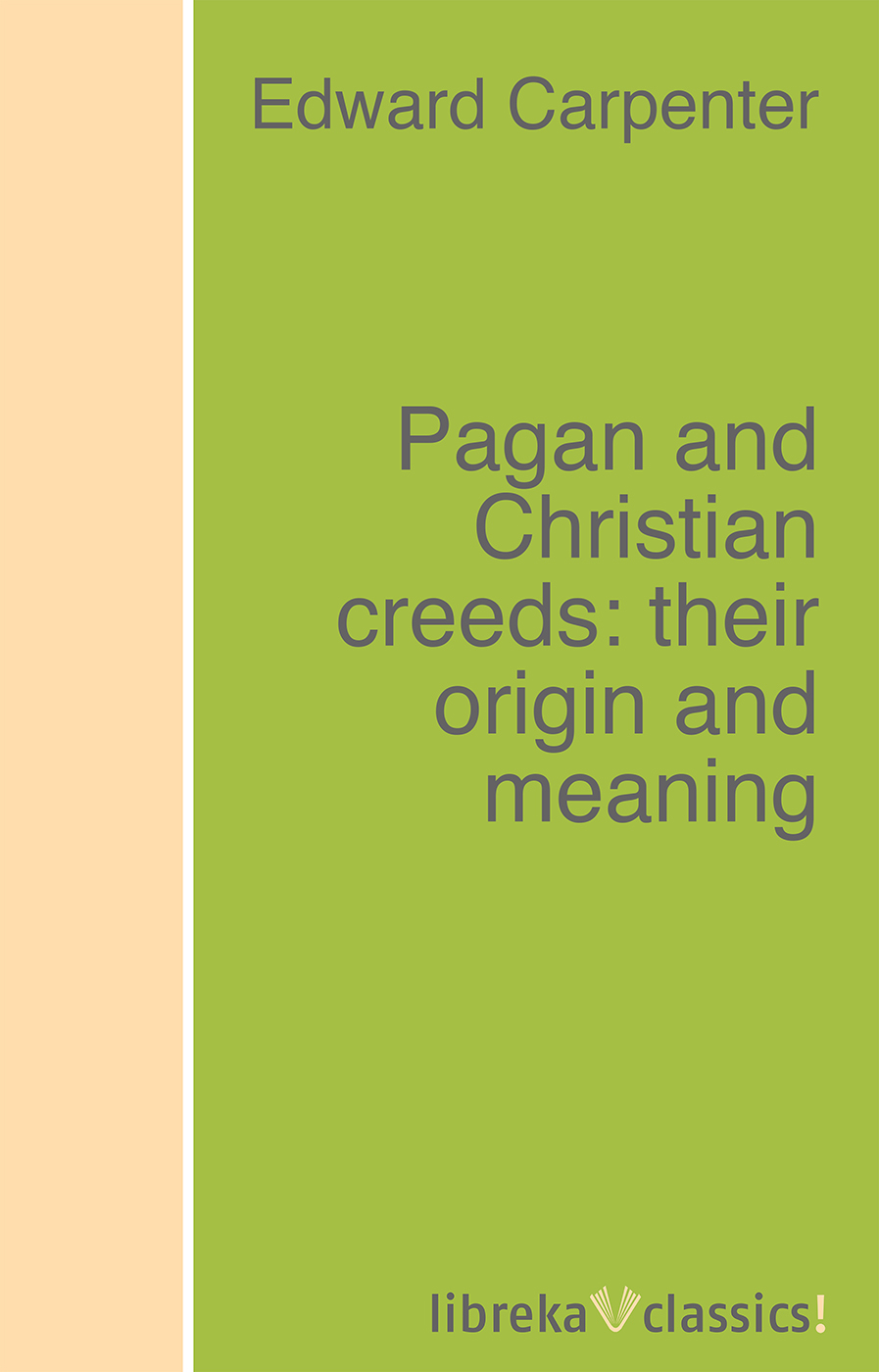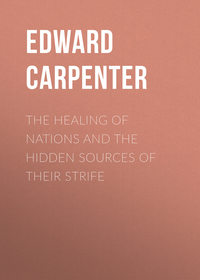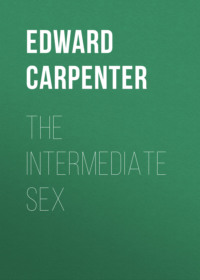
Полная версия
Pagan and Christian creeds: their origin and meaning


Titel: Pagan and Christian creeds: their origin and meaning
von William Shakespeare, H. G. Wells, Henry Van Dyke, Thomas Carlyle, Oscar Wilde, Joseph Conrad, Henry James, Anthony Hope, Henry Fielding, Giraldus Cambrensis, Daniel Defoe, Grammaticus Saxo, Edgar Rice Burroughs, Hugh Lofting, Agatha Christie, Sinclair Lewis, Eugène Brieux, Upton Sinclair, Booth Tarkington, Sax Rohmer, Jack London, Anna Katharine Green, Sara Jeannette Duncan, Xenophon, Alexandre Dumas père, John William Draper, Alice Christiana Thompson Meynell, Bram Stoker, Honoré de Balzac, William Congreve, Louis de Rougemont, Nikolai Vasilievich Gogol, Rolf Boldrewood, François Rabelais, Lysander Spooner, B. M. Bower, Henry Rider Haggard, William Hickling Prescott, Lafcadio Hearn, Robert Herrick, Jane Austen, Mark Twain, Mary Roberts Rinehart, Charles Babbage, Kate Douglas Smith Wiggin, Frank L. Packard, George Meredith, John Merle Coulter, Irvin S. Cobb, Edwin Mims, John Tyndall, Various, Charles Darwin, Sidney Lanier, Henry Lawson, Niccolò Machiavelli, George W. Crile, Théophile Gautier, Noah Brooks, James Thomson, Zane Grey, J. M. Synge, Virginia Woolf, Conrad Aiken, Edna St. Vincent Millay, Helen Cody Wetmore, Ayn Rand, Sir Thomas Malory, Gustave Flaubert, Edmond Rostand, Charlotte Brontë, Edith Wharton, Giles Lytton Strachey, Myrtle Reed, Ernest Bramah, Jules Verne, H. L. Mencken, H. Stanley Redgrove, Victor Lefebure, Edna Lyall, John Masefield, Charles Kingsley, Robert Burns, Edgar Lee Masters, Victor [pseud.] Appleton, Ellis Parker Butler, Mary Lamb, Charles Lamb, Johann Wolfgang von Goethe, Kenneth Grahame, Charles Dickens, John Ruskin, John Galt, James J. Davis, Owen Wister, William Blades, Sir Hall Caine, Sir Max Beerbohm, Baron Edward John Moreton Drax Plunkett Dunsany, Bret Harte, E. Phillips Oppenheim, Thomas Henry Huxley, A. B. Paterson, John N. Reynolds, Walter Dill Scott, Hans Gustav Adolf Gross, T. S. Eliot, Walt Whitman, Arthur Ransome, Jane Addams, Elizabeth, David Lindsay, Helen Bannerman, Charles A. Oliver, J. M. Barrie, Robert F. Murray, Andrew Lang, Jerome K. Jerome, Francis Thompson, Sydney Waterlow, Andrew Dickson White, Benjamin N. Cardozo, Karl Marx, Edouard Louis Emmanuel Julien Le Roy, Margaret Hill McCarter, Sir Donald Mackenzie Wallace, Howard Trueman, L. M. Montgomery, Frank T. Bullen, Baron Alfred Tennyson Tennyson, Jonathan Nield, Henry Wadsworth Longfellow, Charles Reade, Ouida, Washington Irving, Benjamin Louis Eulalie de Bonneville, Sir Walter Scott, Stewart Edward White, Arthur Hugh Clough, Baron Edward Bulwer Lytton Lytton, C.-F. Volney, T. Troward, graf Leo Tolstoy, Christopher Morley, James Madison, Alexander Hamilton, John Jay, Gilbert White, Percival Lowell, Frederick Marryat, Robert Graves, Thomas Holmes, Wilkie Collins, Maria Edgeworth, Katherine Mansfield, E. Nesbit, Olive Schreiner, Jeronimo Lobo, O. Henry, James Slough Zerbe, Donald Ogden Stewart, Johanna Spyri, Eleanor H. Porter, William Tatem Tilden, Sol Plaatje, Rafael Sabatini, William Makepeace Thackeray, George Gissing, Maksim Gorky, Baron Thomas Babington Macaulay Macaulay, H. G. Keene, Saki, R. B. Cunninghame Graham, Thomas Hughes, David Nunes Carvalho, Vicente Blasco Ibáñez, Carry Amelia Nation, John Fiske, Bernard Shaw, Elbridge Streeter Brooks, William Holmes McGuffey, Edward Everett Hale, Louis Ginzberg, Chester K. Steele, Christopher Marlowe, Plato, John Lord, Shakespeare, Martin Luther, Frances Hodgson Burnett, Howard Pyle, Charles Morris, Edward Carpenter
ISBN 978-3-7429-1505-4
Alle Rechte vorbehalten.
Es ist ohne vorherige schriftliche Erlaubnis nicht gestattet, dieses Werk im Ganzen oder in Teilen zu vervielfältigen oder zu veröffentlichen.
PAGAN & CHRISTIAN CREEDS:
THEIR ORIGIN AND MEANING
By Edward Carpenter
"The different religions being lame attempts to represent under various guises this one root-fact of the central universal life, men have at all times clung to the religious creeds and rituals and ceremonials as symbolising in some rude way the redemption and fulfilment of their own most intimate natures—and this whether consciously understanding the interpretations, or whether (as most often) only doing so in an unconscious or quite subconscious way."
The Drama of Love and Death, p. 96.
Contents
PAGAN AND CHRISTIAN CREEDS: THEIR ORIGIN AND MEANING I. INTRODUCTORY II. SOLAR MYTHS AND CHRISTIAN FESTIVALS III. THE SYMBOLISM OF THE ZODIAC IV. TOTEM-SACRAMENTS AND EUCHARISTS V. FOOD AND VEGETATION MAGIC VI. MAGICIANS, KINGS AND GODS VII. RITES OF EXPIATION AND REDEMPTION VIII. PAGAN INITIATIONS AND THE SECOND BIRTH IX. MYTH OF THE GOLDEN AGE X. THE SAVIOUR-GOD AND THE VIRGIN-MOTHER XI. RITUAL DANCING XII. THE SEX-TABOO XIII. THE GENESIS OF CHRISTIANITY XIV. THE MEANING OF IT ALL XV. THE ANCIENT MYSTERIES XVI. THE EXODUS OF CHRISTIANITY XVII. CONCLUSION APPENDIX
PAGAN AND CHRISTIAN CREEDS: THEIR ORIGIN AND MEANING
I. INTRODUCTORY
The subject of Religious Origins is a fascinating one, as the great multitude of books upon it, published in late years, tends to show. Indeed the great difficulty to-day in dealing with the subject, lies in the very mass of the material to hand—and that not only on account of the labor involved in sorting the material, but because the abundance itself of facts opens up temptation to a student in this department of Anthropology (as happens also in other branches of general Science) to rush in too hastily with what seems a plausible theory. The more facts, statistics, and so forth, there are available in any investigation, the easier it is to pick out a considerable number which will fit a given theory. The other facts being neglected or ignored, the views put forward enjoy for a time a great vogue. Then inevitably, and at a later time, new or neglected facts alter the outlook, and a new perspective is established.
There is also in these matters of Science (though many scientific men would doubtless deny this) a great deal of "Fashion". Such has been notoriously the case in Political Economy, Medicine, Geology, and even in such definite studies as Physics and Chemistry. In a comparatively recent science, like that with which we are now concerned, one would naturally expect variations. A hundred and fifty years ago, and since the time of Rousseau, the "Noble Savage" was extremely popular; and he lingers still in the story books of our children. Then the reaction from this extreme view set in, and of late years it has been the popular cue (largely, it must be said, among "armchair" travelers and explorers) to represent the religious rites and customs of primitive folk as a senseless mass of superstitions, and the early man as quite devoid of decent feeling and intelligence. Again, when the study of religious origins first began in modern times to be seriously taken up—say in the earlier part of last century—there was a great boom in Sungods. Every divinity in the Pantheon was an impersonation of the Sun—unless indeed (if feminine) of the Moon. Apollo was a sungod, of course; Hercules was a sungod; Samson was a sungod; Indra and Krishna, and even Christ, the same. C. F. Dupuis in France (Origine de tous les Cultes, 1795), F. Nork in Germany (Biblische Mythologie, 1842), Richard Taylor in England (The Devil's Pulpit, (1) 1830), were among the first in modern times to put forward this view. A little later the PHALLIC explanation of everything came into fashion. The deities were all polite names for the organs and powers of procreation. R. P. Knight (Ancient Art and Mythology, 1818) and Dr. Thomas Inman (Ancient Faiths and Ancient Names, 1868) popularized this idea in England; so did Nork in Germany. Then again there was a period of what is sometimes called Euhemerism—the theory that the gods and goddesses had actually once been men and women, historical characters round whom a halo of romance and remoteness had gathered. Later still, a school has arisen which thinks little of sungods, and pays more attention to Earth and Nature spirits, to gnomes and demons and vegetation-sprites, and to the processes of Magic by which these (so it was supposed) could be enlisted in man's service if friendly, or exorcised if hostile.
It is easy to see of course that there is some truth in ALL these explanations; but naturally each school for the time being makes the most of its own contention. Mr. J. M. Robertson (Pagan Christs and Christianity and Mythology), who has done such fine work in this field, (1) relies chiefly on the solar and astronomical origins, though he does not altogether deny the others; Dr. Frazer, on the other hand—whose great work, The Golden Bough, is a monumental collection of primitive customs, and will be an inexhaustible quarry for all future students—is apparently very little concerned with theories about the Sun and the stars, but concentrates his attention on the collection of innumerable details (2) of rites, chiefly magical, connected with food and vegetation. Still later writers, like S. Reinach, Jane Harrison and E. A. Crowley, being mainly occupied with customs of very primitive peoples, like the Pelasgian Greeks or the Australian aborigines, have confined themselves (necessarily) even more to Magic and Witchcraft.
Meanwhile the Christian Church from these speculations has kept itself severely apart—as of course representing a unique and divine revelation little concerned or interested in such heathenisms; and moreover (in this country at any rate) has managed to persuade the general public of its own divine uniqueness to such a degree that few people, even nowadays, realize that it has sprung from just the same root as Paganism, and that it shares by far the most part of its doctrines and rites with the latter. Till quite lately it was thought (in Britain) that only secularists and unfashionable people took any interest in sungods; and while it was true that learned professors might point to a belief in Magic as one of the first sources of Religion, it was easy in reply to say that this obviously had nothing to do with Christianity! The Secularists, too, rather spoilt their case by assuming, in their wrath against the Church, that all priests since the beginning of the world have been frauds and charlatans, and that all the rites of religion were merely devil's devices invented by them for the purpose of preying upon the superstitions of the ignorant, to their own enrichment. They (the Secularists) overleaped themselves by grossly exaggerating a thing that no doubt is partially true.
Thus the subject of religious origins is somewhat complex, and yields many aspects for consideration. It is only, I think, by keeping a broad course and admitting contributions to the truth from various sides, that valuable results can be obtained. It is absurd to suppose that in this or any other science neat systems can be found which will cover all the facts. Nature and History do not deal in such things, or supply them for a sop to Man's vanity.
It is clear that there have been three main lines, so far, along which human speculation and study have run. One connecting religious rites and observations with the movements of the Sun and the planets in the sky, and leading to the invention of and belief in Olympian and remote gods dwelling in heaven and ruling the Earth from a distance; the second connecting religion with the changes of the season, on the Earth and with such practical things as the growth of vegetation and food, and leading to or mingled with a vague belief in earth-spirits and magical methods of influencing such spirits; and the third connecting religion with man's own body and the tremendous force of sex residing in it—emblem of undying life and all fertility and power. It is clear also—and all investigation confirms it—that the second-mentioned phase of religion arose on the whole BEFORE the first-mentioned—that is, that men naturally thought about the very practical questions of food and vegetation, and the magical or other methods of encouraging the same, before they worried themselves about the heavenly bodies and the laws of THEIR movements, or about the sinister or favorable influences the stars might exert. And again it is extremely probable that the third-mentioned aspect—that which connected religion with the procreative desires and phenomena of human physiology—really came FIRST. These desires and physiological phenomena must have loomed large on the primitive mind long before the changes of the seasons or of the sky had been at all definitely observed or considered. Thus we find it probable that, in order to understand the sequence of the actual and historical phases of religious worship, we must approximately reverse the order above-given in which they have been STUDIED, and conclude that in general the Phallic cults came first, the cult of Magic and the propitiation of earth-divinities and spirits came second, and only last came the belief in definite God-figures residing in heaven.
At the base of the whole process by which divinities and demons were created, and rites for their propitiation and placation established, lay Fear—fear stimulating the imagination to fantastic activity. Primus in orbe deos fecit Timor. And fear, as we shall see, only became a mental stimulus at the time of, or after, the evolution of self-consciousness. Before that time, in the period of SIMPLE consciousness, when the human mind resembled that of the animals, fear indeed existed, but its nature was more that of a mechanical protective instinct. There being no figure or image of SELF in the animal mind, there were correspondingly no figures or images of beings who might threaten or destroy that self. So it was that the imaginative power of fear began with Self-consciousness, and from that imaginative power was unrolled the whole panorama of the gods and rites and creeds of Religion down the centuries.
The immense force and domination of Fear in the first self-conscious stages of the human mind is a thing which can hardly be exaggerated, and which is even difficult for some of us moderns to realize. But naturally as soon as Man began to think about himself—a frail phantom and waif in the midst of tremendous forces of whose nature and mode of operation he was entirely ignorant—he was BESET with terrors; dangers loomed upon him on all sides. Even to-day it is noticed by doctors that one of the chief obstacles to the cure of illness among some black or native races is sheer superstitious terror; and Thanatomania is the recognized word for a state of mind ("obsession of death") which will often cause a savage to perish from a mere scratch hardly to be called a wound. The natural defence against this state of mind was the creation of an enormous number of taboos—such as we find among all races and on every conceivable subject—and these taboos constituted practically a great body of warnings which regulated the lives and thoughts of the community, and ultimately, after they had been weeded out and to some degree simplified, hardened down into very stringent Customs and Laws. Such taboos naturally in the beginning tended to include the avoidance not only of acts which might reasonably be considered dangerous, like touching a corpse, but also things much more remote and fanciful in their relation to danger, like merely looking at a mother-in-law, or passing a lightning-struck tree; and (what is especially to be noticed) they tended to include acts which offered any special PLEASURE or temptation—like sex or marriage or the enjoyment of a meal. Taboos surrounded these things too, and the psychological connection is easy to divine: but I shall deal with this general subject later.
It may be guessed that so complex a system of regulations made life anything but easy to early peoples; but, preposterous and unreasonable as some of the taboos were, they undoubtedly had the effect of compelling the growth of self-control. Fear does not seem a very worthy motive, but in the beginning it curbed the violence of the purely animal passions, and introduced order and restraint among them. Simultaneously it became itself, through the gradual increase of knowledge and observation, transmuted and etherealized into something more like wonder and awe and (when the gods rose above the horizon) into reverence. Anyhow we seem to perceive that from the early beginnings (in the Stone Age) of self-consciousness in Man there has been a gradual development—from crass superstition, senseless and accidental, to rudimentary observation, and so to belief in Magic; thence to Animism and personification of nature-powers in more or less human form, as earth-divinities or sky-gods or embodiments of the tribe; and to placation of these powers by rites like Sacrifice and the Eucharist, which in their turn became the foundation of Morality. Graphic representations made for the encouragement of fertility—as on the walls of Bushmen's rock-dwellings or the ceilings of the caverns of Altamira—became the nurse of pictorial Art; observations of plants or of the weather or the stars, carried on by tribal medicine-men for purposes of witchcraft or prophecy, supplied some of the material of Science; and humanity emerged by faltering and hesitating steps on the borderland of those finer perceptions and reasonings which are supposed to be characteristic of Civilization.
The process of the evolution of religious rites and ceremonies has in its main outlines been the same all over the world, as the reader will presently see—and this whether in connection with the numerous creeds of Paganism or the supposedly unique case of Christianity; and now the continuity and close intermixture of these great streams can no longer be denied—nor IS it indeed denied by those who have really studied the subject. It is seen that religious evolution through the ages has been practically One thing—that there has been in fact a World-religion, though with various phases and branches.
And so in the present day a new problem arises, namely how to account for the appearance of this great Phenomenon, with its orderly phases of evolution, and its own spontaneous (1) growths in all corners of the globe—this phenomenon which has had such a strange sway over the hearts of men, which has attracted them with so weird a charm, which has drawn out their devotion, love and tenderness, which has consoled them in sorrow and affliction, and yet which has stained their history with such horrible sacrifices and persecutions and cruelties. What has been the instigating cause of it?
The answer which I propose to this question, and which is developed to some extent in the following chapters, is a psychological one. It is that the phenomenon proceeds from, and is a necessary accompaniment of, the growth of human Consciousness itself—its growth, namely, through the three great stages of its unfoldment. These stages are (1) that of the simple or animal consciousness, (2) that of SELF-consciousness, and (3) that of a third stage of consciousness which has not as yet been effectively named, but whose indications and precursive signs we here and there perceive in the rites and prophecies and mysteries of the early religions, and in the poetry and art and literature generally of the later civilizations. Though I do not expect or wish to catch Nature and History in the careful net of a phrase, yet I think that in the sequence from the above-mentioned first stage to the second, and then again in the sequence from the second to the third, there will be found a helpful explanation of the rites and aspirations of human religion. It is this idea, illustrated by details of ceremonial and so forth, which forms the main thesis of the present book. In this sequence of growth, Christianity enters as an episode, but no more than an episode. It does not amount to a disruption or dislocation of evolution. If it did, or if it stood as an unique or unclassifiable phenomenon (as some of its votaries contend), this would seem to be a misfortune—as it would obviously rob us of at any rate one promise of progress in the future. And the promise of something better than Paganism and better than Christianity is very precious. It is surely time that it should be fulfilled.
The tracing, therefore, of the part that human self-consciousness has played, psychologically, in the evolution of religion, runs like a thread through the following chapters, and seeks illustration in a variety of details. The idea has been repeated under different aspects; sometimes, possibly, it has been repeated too often; but different aspects in such a case do help, as in a stereoscope, to give solidity to the thing seen. Though the worship of Sun-gods and divine figures in the sky came comparatively late in religious evolution, 1 have put this subject early in the book (chapters ii and iii), partly because (as I have already explained) it was the phase first studied in modern times, and therefore is the one most familiar to present-day readers, and partly because its astronomical data give great definiteness and "proveability" to it, in rebuttal to the common accusation that the whole study of religious origins is too vague and uncertain to have much value. Going backwards in Time, the two next chapters (iv and v) deal with Totem-sacraments and Magic, perhaps the earliest forms of religion. And these four lead on (in chapters vi to xi) to the consideration of rites and creeds common to Paganism and Christianity. XII and xiii deal especially with the evolution of Christianity itself; xiv and xv explain the inner Meaning of the whole process from the beginning; and xvi and xvii look to the Future.
The appendix on the doctrines of the Upanishads may, I hope, serve to give an idea, intimate even though inadequate, of the third Stage—that which follows on the stage of self-consciousness; and to portray the mental attitudes which are characteristic of that stage. Here in this third stage, it would seem, one comes upon the real FACTS of the inner life—in contradistinction to the fancies and figments of the second stage; and so one reaches the final point of conjunction between Science and Religion.
II. SOLAR MYTHS AND CHRISTIAN FESTIVALS
To the ordinary public—notwithstanding the immense amount of work which has of late been done on this subject—the connection between Paganism and Christianity still seems rather remote. Indeed the common notion is that Christianity was really a miraculous interposition into and dislocation of the old order of the world; and that the pagan gods (as in Milton's Hymn on the Nativity) fled away in dismay before the sign of the Cross, and at the sound of the name of Jesus. Doubtless this was a view much encouraged by the early Church itself—if only to enhance its own authority and importance; yet, as is well known to every student, it is quite misleading and contrary to fact. The main Christian doctrines and festivals, besides a great mass of affiliated legend and ceremonial, are really quite directly derived from, and related to, preceding Nature worships; and it has only been by a good deal of deliberate mystification and falsification that this derivation has been kept out of sight.




